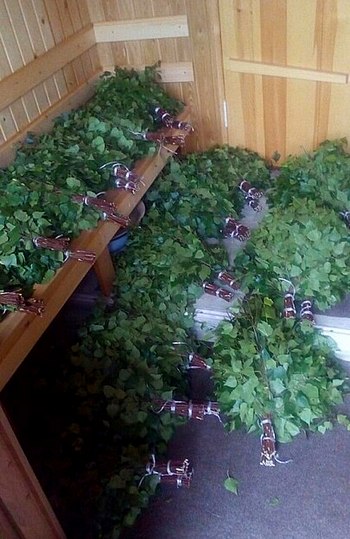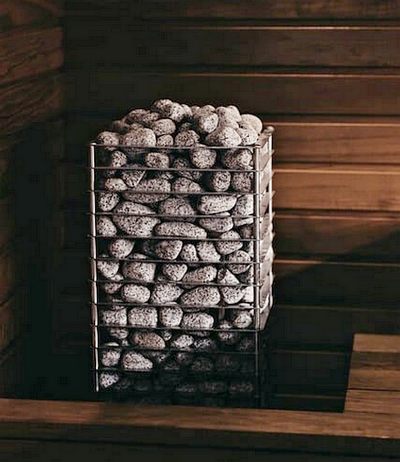Both Finnish and Russian saunas are popular amongst population of their countries, and have many similarities. This is because Finland was under control of Russian empire (as an autonomous state) from 1809 and 1917. And while Finnish sauna has many similarities with Russian banya (that’s how Russians prefer to call it), there are also differences. In this post, we will discover differences between Finnish sauna and Russian banya.
The main differences between Finnish and Russian saunas are temperature and humidity, heater type, materials used, what people do in sauna (whisk is common in Russian banya) and more.
Temperature and humidity levels
One the main differences between Finnish sauna and Russian banya are temperatures and humidity levels inside. In Finnish sauna, humidity levels are very low, usually ranging between 8-15%, resulting in dry air. In a Russian banya, humidity levels are much higher, ranging between 50-90% and resulting in wet air.
Temperature differences are also considerable. In a Finnish sauna, temperatures generally range between 200-265 F (around 90-130 Celsius), while in a Russian banya around 140 to 185 F on a higher bench (60-85 Celsius).
Because of low humidity levels in a Finnish sauna, a person’s body heats and sweats more effectively, so there is a low chance of overheating (good thermoregulation). A person entering sauna is initially dry, and body tries its best to limit sweating in order not to lose water. Blood starts moving towards internal organs and away from the skin. But once the body gets very hot, pores open up, blood pools close to the skin and you start sweating profusely.
In a Russian sauna, where air is wet, your sweat doesn’t evaporate easily, but rather drips down as droplets. This allows good and uniform warming of a body, but not the best thermoregulation. But a positive point is that there is a low chance of dehydration in a Russian banya.
Another point to make is that Finnish sauna often involves use of a swimming pool (if indoors). This helps to maximize benefits of sauna use – alternating warm air and cool water. In a Russian banya, most people can be seen pouring water on themselves or jumping in a cold pool/lake/dipping in ice holes. In modern banyas, you can also find swimming pools. And Finns are also fond of cold plunges.
Sauna whisk

A very important attribute of a Russian banya is a sauna whisk. Having said that, Finnish saunas also feature use of whisks. People in Finland can be seen using whisks during Midsummer, which is a traditional holiday in Finland symbolizing connection to nature, purification and healing. The only thing that might make using whisks harder in a Finnish sauna is low humidity, that can lead to twigs and leaves drying and falling out. But to avoid this, whisk is soaked in water (cold water if it’s fresh and warm if it’s a dried whisk) before use.
This whisk is made of a bunch of tree twigs, usually oak and birch. This whisk is used to splash water on a heater stove, ‘catching’ steam from top of the banya room and directing it at sauna users, for a good smell in a banya and massage. Performing a massage using these whisks helps improve blood circulation, removes dead skin cells and dirt.
What is more, twigs that are used to make these whisks, contain essential oils as well as phytoncides, which are natural antibacterial and antifungal compounds. So, using them in a sauna helps maximize bathing experience, and helps fight colds and infections. Essential oils are great for overall health and improving metabolism and promoting youthful appearance.
Heater

Another difference between Russian and Finnish sauna is a heater generally used in them. In a traditional Russian banya, a wooden stove (traditionally heated with logs) with stones that cover it is installed, but nowadays, other types of stoves are also used, including cast iron ones (warms up quickly) or steel (long-lasting heat etc.).
You will also find a cauldron of water on top of a stove, that heats the water and brings it to boil. The water inside this cauldron also evaporates, raising humidity levels inside a Russian banya. Another great thing is that people spray herbal infused water (mint, sage and many more) to benefit from essential oils in the air.
In a Russian banya, rocks are heated more than the air, and the aim is to keep adding hot water on the rocks to increase humidity. In a Finnish sauna, rocks are often open, and the air is rapidly heated through high convection. But to be fair, there are heaters that can work for both banya and sauna settings.
In Finland, you will often find electric heaters inside saunas that are used for heating. Heaters inside Finnish saunas often only warm the air. Splashing water on the stove/heater rocks is called Löyly. It is considered to be an essence of a Finnish sauna. However, generally water is only splashed rarely and in small amounts. That’s because high temperature and high humidity (raising from the splashed water) is often too much to bear and can even be dangerous.
Materials
In spite of the variations in temperature and humidity levels, Russian and Finnish saunas share many common features (there is a little structural differences between them). The interior of the sauna room is made from wood. Typically, non-resinous type of wood are used, such as linden and aspen. That’s because when heated, conifers emit resin that can easily burn or become dirty. So, the interior of the steam room is finished with hardwood paneling from linden, aspen, or alder. Insulation is provided by hemp, jute, or materials based on mineral wool. The Finnish sauna is noted for its fusion of natural lumber and ceramic tiles.
To prevent burns when using a sauna, the room must be free of metal or plastic elements. Items such as ladders, handles, benches, tubs, basins and various other elements are crafted from wood.
Conclusion
To conclude, you might be asking, which is better, Finnish sauna or Russian banya? Well, both are great and the one you choose will depend on your goals and personal preferences. Russian banya is great for the skin, overall health and well being. And Finnish sauna can be great for post-exercise relaxation and to remove tension from muscles (dry air helps with that). In this case, you might wish to visit both!
